No matter how far down the rabbit hole you go, the scenery never changes.
This is the thought one might have if the mathematical world of fractals was a path in the woods, and you were a traveler on an endless journey from where you are to where you are. Fractals are a complicated, yet a surprisingly simple, subject to outline.
A good introduction might be the movie Inception.
In the film, the characters travel into dreams inside of dreams inside of dreams on a journey to get to the pure subconscious of the brain. It takes the example of Russian Matryoshka dolls (or nesting dolls) and turns it into an exciting ride through the dark recesses of the mind.
The dolls themselves are a good analogy of fractals, simplified, to better digest the implications of the never-ending self-similarity of chaotic systems.
A set of nesting dolls comprises ever smaller dolls, each fitting inside the larger. Eventually the smallest doll is reached.
With fractals, the pattern that you see is made up of the exact same patterns at a smaller scale, and when magnified, the exact same patterns appear to infinity. It is the end result of a simple process repeated to create an unending feedback loop, driven by recursion (repeating items in a self-similar way).
See the pattern?
Basically, digging deeper into fractals means ending up where you started since the entire system looks the same from any point. If the idea is still unclear and you were hoping for a nice watch-related example, you have come to the right place.
The most relevant example of this is a tourbillon that is made of smaller tourbillons: the new piece from AHCI member Antoine Preziuso is aptly named Tourbillon of Tourbillons.
Fractals in the metal
The Tourbillon of Tourbillons embodies the ideas of fractal geometry and recursion by producing a ten-minute tourbillon driven by three sixty-second tourbillons, the first layer of recursion.
Now, this is where the recursion ends (since attempting to make those three tourbillons out of nine micro tourbillons would be insanity), but it clearly helps the brain wrap around the idea of a something being made out of smaller versions of itself.
That is also where we start our dissection, because it really is the meat of the matter. Three tourbillon carriages are connected via a three-way differential in the center, mounted on a rotating carriage whose period of rotation is ten minutes. This is pretty fast considering it’s almost half of the entire movement moving around in that amount of time.
The differential in the center is a planetary gear system that took three years to design and manufacture to Preziuso’s satisfaction. It was designed to distribute power evenly to the three tourbillons at once, something that is much more difficult to achieve than linking two or four tourbillons via a differential (which others have done). This differential connects to the tourbillons via three idler pinions and is driven by two beefy mainsprings.
Inside that differential is where a set of micro ball bearings keeps things rolling smoothly. A lot of friction can be introduced with differentials (lots of metal moving in a very confined space), so adding ball bearings to such a mechanism is a better solution than trying to mount a host of jewels and worrying about lubricating them all once assembled.
Onto the big carriage
Once you move outside of the central differential and onto the big tourbillon carriage, things become really interesting. The main carriage is sort of like a six-pointed star, if three of the points were actually spinning circles and the other three gold counterweights. Between the three tourbillons sit three gold plugs designed to balance the assembly as well as reduce friction and any off-center rotation that could bring the entire movement to a grinding halt.
Getting a tourbillon to spin smoothly is already a test of balance and fine adjustment, but getting three to spin smoothly multiplies that difficulty threefold . . . and then some! But imagine if you took those three perfectly spinning tourbillons and mounted them into a fourth carriage that needed to spin smoothly, all while the three assemblies rotated inside it and potentially unbalancing the entire system. With the amount of components attached to that large fourth carriage, there are a lot of places for weight to be unevenly distributed.
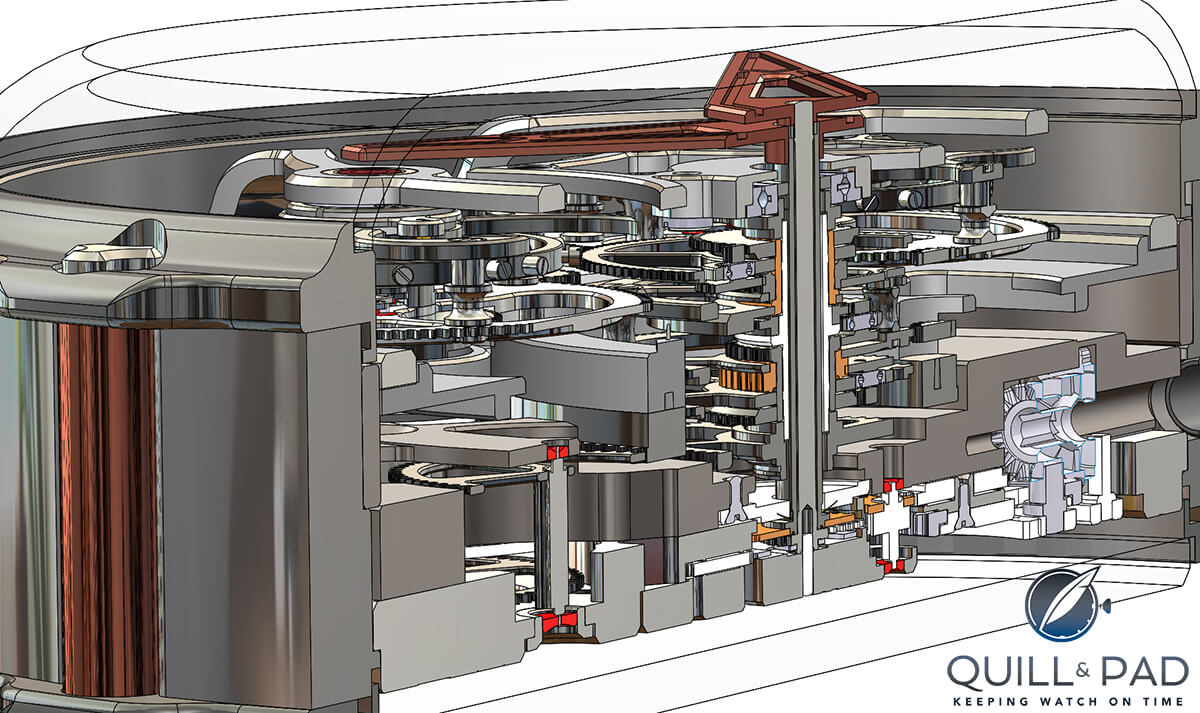
This cross section of the movement of the Antoine Preziuso Tourbillon of Tourbillons offers a glimpse into its incredible complexity
The end result is astonishing once you start to consider the painstaking amount of effort that went into simply making sure the carriage and enclosed tourbillons were as balanced as possible. That main cage also takes up the entire dial, literally, so the distances involved in keeping things balanced is no small consideration. But with the fine crafting of the still-delicate fourth carriage and the clear attention to detail for the individual tourbillons, the result (and visual effect) is awondersome.
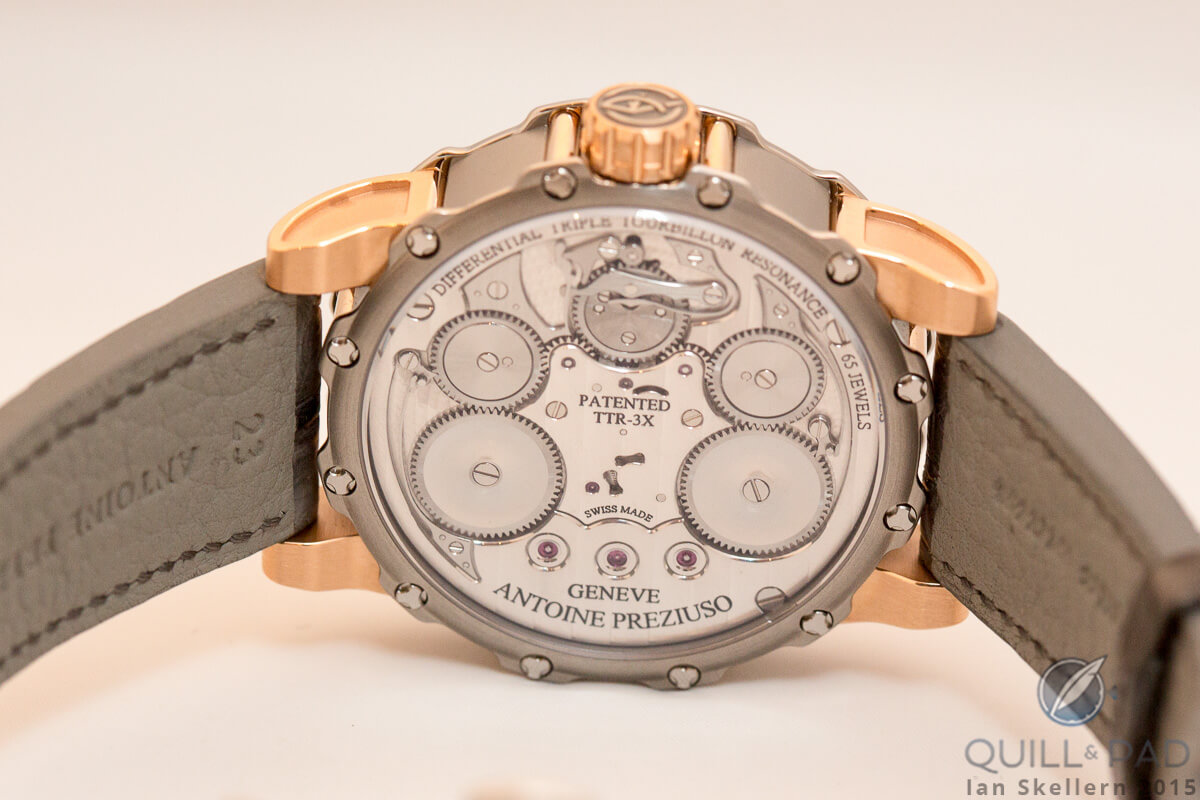
The relatively “minimalist” view through the display back of the Antoine Preziuso Tourbillon of Tourbillons
Flip it, flip it good
After the complexity and boundary-pushing display on the front, one might expect something crazy on the reverse, but this is not the case. The display back shows off the very cleanly balanced and symmetrical double mainsprings branching off from the winding mechanism. This side of the movement features very traditional finishing techniques, all done beautifully, to showcase the classic origins of the very modern tourbillons on the front.
It is also here that you get a sneak peak at a word that hints at a feature not really mentioned by anyone but spoken of in a short, two-sentence paragraph in the press release: resonance. It is claimed that the proximity of the tourbillons to each other creates the phenomenon of resonance between each of their respective three-Hertz frequencies.
Now, based on what we have all learned from the exquisite Duality by Philippe Dufour, two balances oscillating in such close proximity that the outer diameters are almost touching creates a feedback mechanism (resonance) between the two balances. This means they alter their individual rates to match each other and thus help keep the other’s rate stable. But this requires extreme proximity, something not really seen in the Tourbillon of Tourbillons.
That being said, the three oscillating balances all connected to a single differential might bring all of the rates to within a very small margin of each other, though I believe for a reason different than pure resonance and probably not as closely as two resonating balances. A better example from Antoine Preziuso might be his Triple Tourbillon Résonance 3 movement found in the 3Volution timepiece introduced back in 2005. The tourbillons are doing essentially the same thing here, only much more tightly packed.
In the end, we are still left with an amazing machine. And as the only indications are minutes and hours, the Tourbillon of Tourbillons is something that exists as much for its own sake as it does as a timepiece.
It is pieces like this that get me excited for the simple fact that people are trying to do something new, not necessarily out of desire for chronometric perfection (which is awesome in different ways), but instead out of a passion for creating amazing mechanisms doing things people never thought of before. This watch fits the bill and is something I would love to spend hours gawking over and dissecting. I would also add it to the category of fractal-inspired objects, to keep us going down the rabbit hole.
And now the breakdown!
- Wowza Factor * 9.8 Inception-style tourbillon made of three smaller tourbillons! Wowza!
- Late Night Lust Appeal * 94.9g » 930.651m/s2 Just shy of 100 Gs, this watch definitely will keep you drooling over its tourbillon goodness until the wee hours of the morning.
- M.G.R. * 69.8 The only thing that keeps this from breaking 70 is the lack of another complication, otherwise it is pretty darn intense!
- Added-Functionitis * N/A For as complicated as it is, it is also one of those why-bother-with-any-complications-because-this-fan-freaking-tastic watch only tells you the hours and minutes. I guess you can skip the Gotta-HAVE-That cream for this deceptively non-swollen swelling.
- Ouch Outline * 12.3 – Breaking Your Almost Big Toe On A Space Heater! I’m unsure as to whether it broke or simply bruised and sprained because it is dang sore, but the safe bet is on not broken. Either way, I would gladly accidentally kick that thing again if I could strap this baby to my wrist!
- Mermaid Moment * Ten Minutes! That is all the time it takes for the tourbillon of tourbillons to make one revolution on the dial. If, after that time, you haven’t booked a hall and a DJ, then just wait another ten minutes for it to go around again!
- Awesome Total * 1,170 Multiply the number of jewels (65) by the number of ball bearings (6) and the number of tourbillons that are inside the tourbillon of tourbillons (3) and you get a very, very respectable awesome total!
For more information, please visit www. antoine-preziuso.com.
Quick Facts
Case: 45 x 14 mm, steel, gold, and titanium
Movement: manually wound Caliber AFP-TTR-3X with three one-minute tourbillons comprising a fourth ten-minute tourbillon carriage
Functions: hours, minutes
Price: starting at 320,000 Swiss francs
























































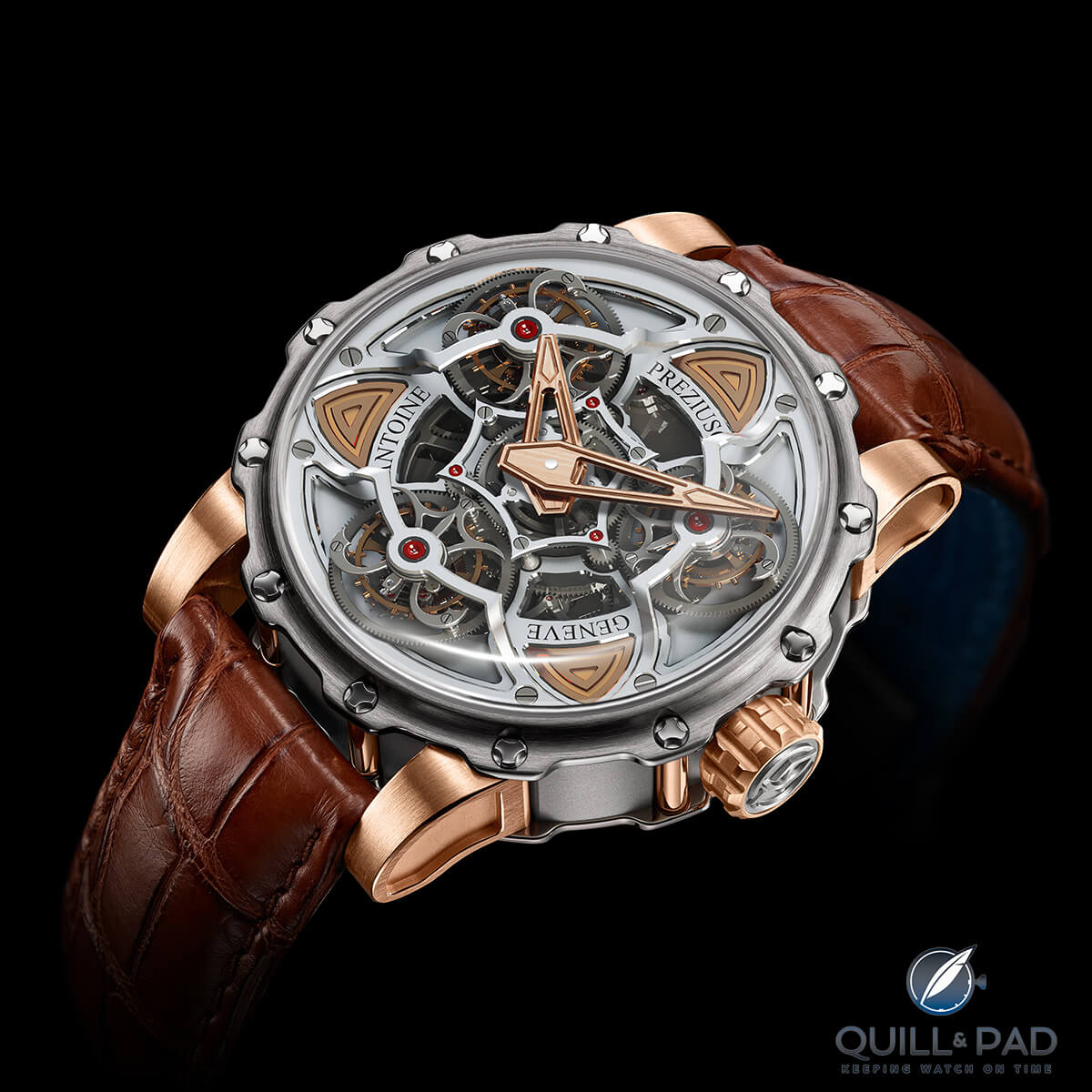
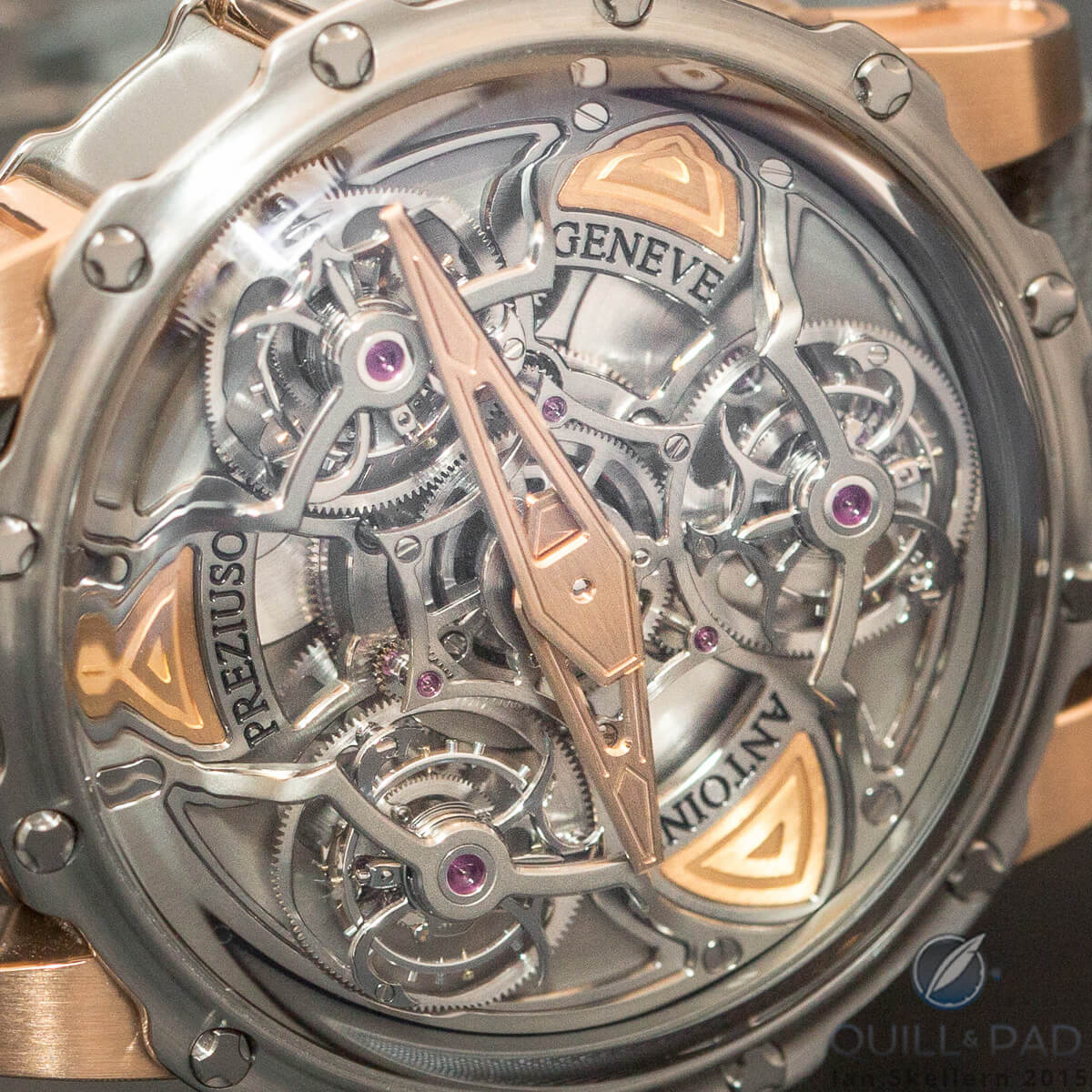
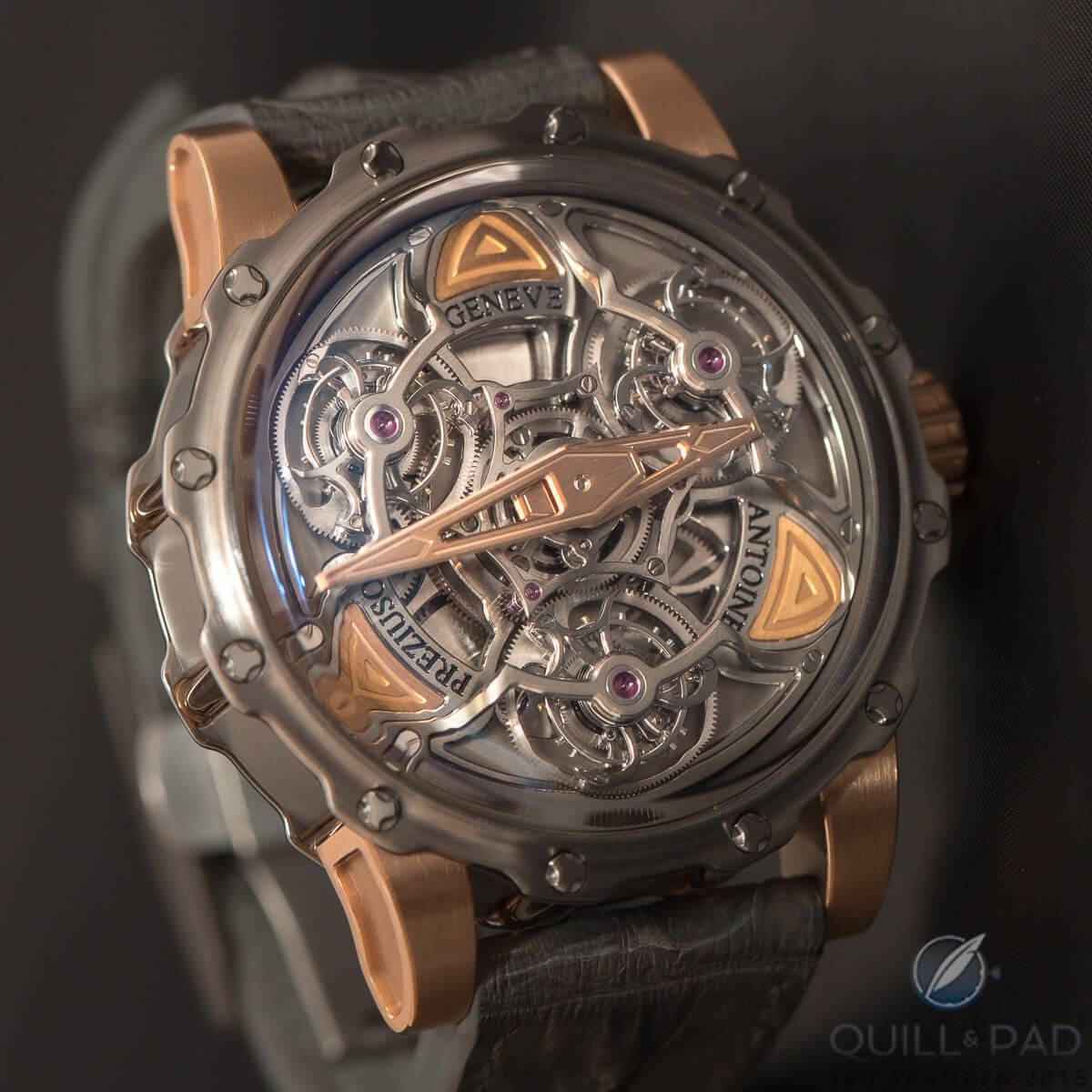

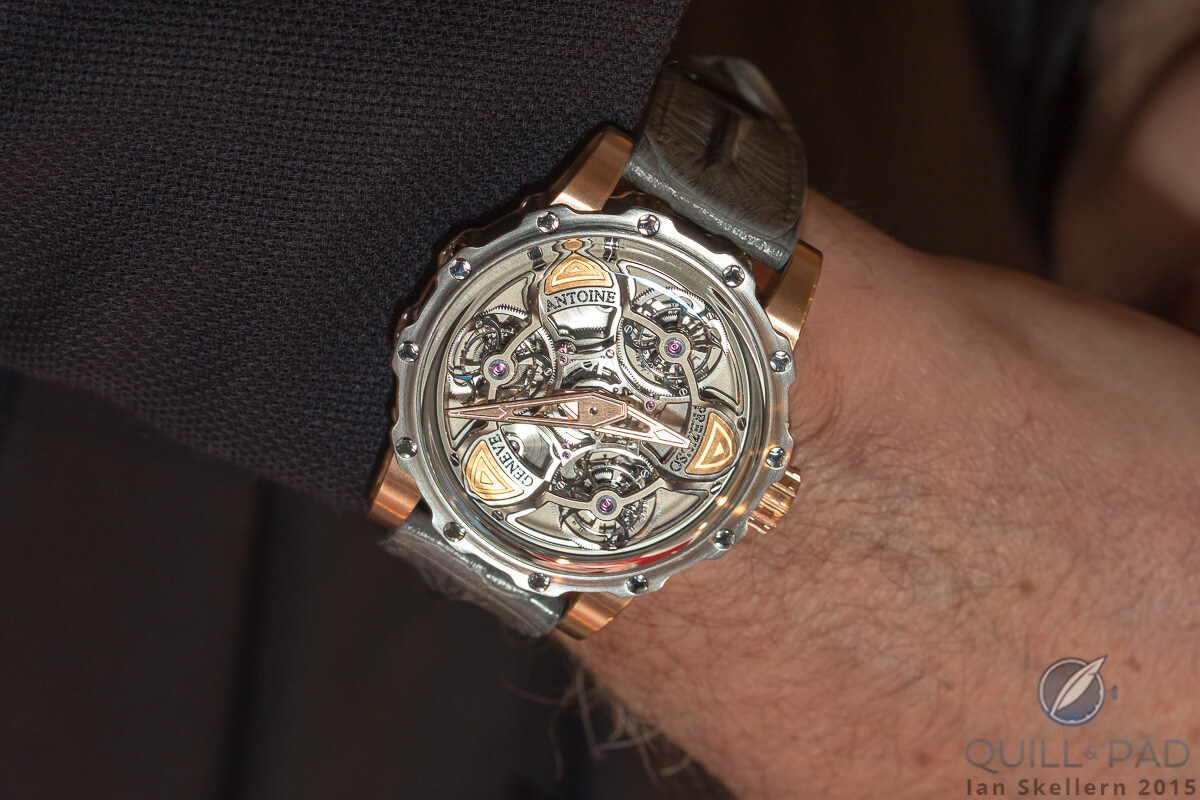
Trackbacks & Pingbacks
[…] the Harmonious Oscillator, double (MB&F Legacy Machine No. 2), triple (Antoine Preziuso Tourbillon Of Tourbillons), and even quadruple regulators (Greubel Forsey Quadruple Tourbillon) have been coupled using […]
[…] Antoine Preziuso collection features the Tourbillon of Tourbillons (2015 winner of both the Public and Innovation prizes at the Grand Prix d’Horlogerie de Genève), […]
[…] For more on this timepiece, please read Antoine Preziuso Tourbillon Of Tourbillons: Fractals Meet ‘Inception.’ […]
[…] d’Horlogerie de Genève for his extremely masculine and robust Tourbillon of Tourbillons (see Antoine Preziuso Tourbillon Of Tourbillons: Fractals Meet ‘Inception’) returns in 2016 with a watch inspired by one of his favorite elements: the heart of a shooting […]
[…] one tourbillon not enough for you? How about three, or is it four? Quill & Pad go deep into the Antoine Preziuso Tourbillon of Tourbillons, which uses three 60 second tourbillons to drive a fourth, ten minute tourbillon. It is beautiful […]
Leave a Reply
Want to join the discussion?Feel free to contribute!